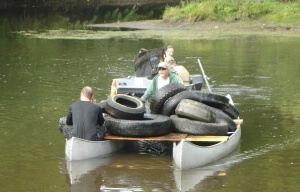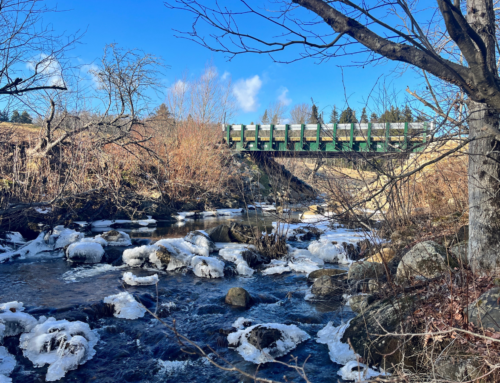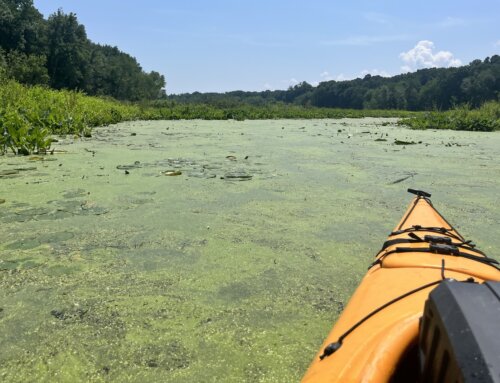 Greenfield, MA – The Connecticut River Conservancy (CRC) hosts their 23rd annual Source to Sea Cleanup on Friday & Saturday, September 27 & 28. In addition to annually coordinating thousands of volunteers to clean up trash in our rivers, CRC continues to work toward solutions to the persistent problem of trash pollution. Trash tires are consistently found during the Source to Sea Cleanup and they never break down in the environment.
Greenfield, MA – The Connecticut River Conservancy (CRC) hosts their 23rd annual Source to Sea Cleanup on Friday & Saturday, September 27 & 28. In addition to annually coordinating thousands of volunteers to clean up trash in our rivers, CRC continues to work toward solutions to the persistent problem of trash pollution. Trash tires are consistently found during the Source to Sea Cleanup and they never break down in the environment.
Tire manufacturers’ argue the tires CRC volunteers find are old and that dumping is no longer a problem. CRC knows that claim is untrue and is asking Source to Sea Cleanup participants to help prove it. Head to CRC’s website to watch a short video explaining how you can find the date a dumped tire was made and submit the results to CRC. You can also help show the tire dumping problem by sharing photos of the tires you find online using #TiredOfTires and submit your photos to CRC’s online photo contest. Learn more about how you can get involved at ctriver.org/takeaction.
“It’s time for tire producers to take greater responsibility for the tires they generate,” says Andrew Fisk, CRC’s executive director. “Pushing the disposal cost to consumers is a recipe for illegal dumping. And it’s our rivers that bear the burden of the pollution.” It’s estimated that over 11 million waste tires are generated each year in NH, VT, MA, and CT. Of those, nearly 600,000 remain unaccounted for and could be ending up in our rivers. In 2018, Cleanup volunteers collected over 1,150 trash tires. This year, for the fourth straight year, CRC will work on clearing out a massive tire dump along the Deerfield River in Massachusetts. CRC is also investigating four newly-found tire dump sites for cleanup in Hinsdale, NH and Vernon, VT.
According to CRC, the solution to this problem is more widespread Extended Producer Responsibility (EPR) programs. EPR programs lead to free, easy disposal of items such as tires, paint, mattresses, electronics, and batteries. Free disposal eliminates the incentive for illegal dumping. EPR works by making producers responsible for the proper recycling and reuse of their product. EPR programs have been successful across the country and the world to turn waste into a reusable commodity. These programs also include advanced market development, which can increase the value of post-consumer materials and provide opportunities for economic development.
“We all have a responsibility to solve this problem,” says Fisk. “We are responsible as consumers to make good choices in how we purchase and dispose of products. Manufacturers, businesses, and government are also responsible and it’s time they do their part. By working together, we can make a real difference for our rivers. These ideas are going to take time, decades even. And we’ll keep at it as long as it takes. But our rivers need change now.”
Over the past 22 years, Source to Sea Cleanup volunteers have removed more than 1,100 tons of trash from our rivers. The Source to Sea Cleanup is a two-day river cleanup coordinated by CRC in all four states of the 410-mile Connecticut River basin (NH, VT, MA, CT). Each fall, thousands of volunteers remove about 50 tons of trash along rivers, streams, parks, boat launches, trails and more. For more information or to register for the event, visit ctriver.org/cleanup.
Eversource is the Lead Source to Sea Cleanup sponsor. “At Eversource we’re committed to caring for the environment and take great care to promote conservation while carefully managing natural and cultural resources,” said Eversource President of Corporate Citizenship Rod Powell. “Working with the CRC at their Source to Sea Cleanup event is an opportunity for our employees to put this passion for the environment into action as we serve the neighborhoods where we work and live.”
Since 1952, Connecticut River Conservancy has been the voice for the Connecticut River watershed, from source to sea. CRC collaborates with partners across four states to protect and advocate for your rivers and educate and engage communities. They bring people together to prevent pollution, improve habitat, and promote enjoyment of your rivers. Healthy rivers support healthy economies. To learn more about CRC, or to make a contribution to help protect your rivers, visit ctriver.org.
###







